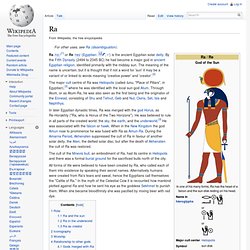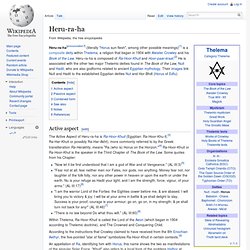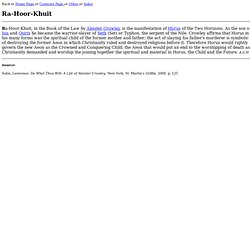

Root Concepts of God in Hermetism. Temple of Babalon.
Nuit. Ra. Ra /rɑː/[1] or Re /reɪ/ (Egyptian: 𓂋ꜥ, rˤ) is the ancient Egyptian solar deity.

By the Fifth Dynasty (2494 to 2345 BC) he had become a major god in ancient Egyptian religion, identified primarily with the midday sun. The meaning of the name is uncertain, but it is thought that if not a word for 'sun' it may be a variant of or linked to words meaning 'creative power' and 'creator'.[2] In later Egyptian dynastic times, Ra was merged with the god Horus, as Re-Horakhty ("Ra, who is Horus of the Two Horizons").
He was believed to rule in all parts of the created world: the sky, the earth, and the underworld.[3] He was associated with the falcon or hawk. When in the New Kingdom the god Amun rose to prominence he was fused with Ra as Amun-Ra. All forms of life were believed to have been created by Ra, who called each of them into existence by speaking their secret names. Role[edit] Ra and the sun[edit] To the Egyptians, the sun represented light, warmth, and growth. Heru-ra-ha. Active aspect[edit] The Active Aspect of Heru-ra-ha is Ra-Hoor-Khuit (Egyptian: Ra-Hoor-Khu-It,[3] Ra-Har-Khuti or possibly Ra-Har-Akht), more commonly referred to by the Greek transliteration Ra-Herakhty, means "Ra (who is) Horus on the Horizon.

"[4] Ra-Hoor-Khuit or Ra-Hoor-Khut is the speaker in the Third Chapter of The Book of the Law. Some quotes from his Chapter: "Now let it be first understood that I am a god of War and of Vengeance. " According to the instructions that Crowley claimed to have received from the 8th Enochian Aethyr, the five-pointed "star of flame" symbolizes Ra-Hoor-Khuit in certain contexts.[9] An appellation of Ra, identifying him with Horus, this name shows the two as manifestations of the singular Solar Force.
Harpocrates. In late Greek mythology as developed in Ptolemaic Alexandria, Harpocrates (Ancient Greek: Ἁρποκράτης) is the god of silence.

Harpocrates was adapted by the Greeks from the Egyptian child god Horus. To the ancient Egyptians, Horus represented the newborn Sun, rising each day at dawn. The Significance of Horus. Ra-Hoor-Khuit. Back to Home Page or Contents Page or Other or Index Ra-Hoor-Khuit Ra-Hoor-Khuit, in the Book of the Law by Aleister Crowley, is the manifestation of Horus of the Two Horizons.

As the son of Isis and Osiris he became the warrior-slayer of Seth (Set) or Typhon, the serpent of the Nile. Crowley affirms that Horus in his many forms was the spiritual child of the former mother and father; the act of slaying his father's murderer is symbolic of destroying the former Aeon in which Christianity ruled and destroyed religions before it. Ancient Egyptian Religion and the Pyramids of Egypt. About Egyptian Pyramids by Jimmy Dunn writing as Alan Winston >> Pyramid Index Religion We see Egypt's ancient pyramids as monumental structures that inspire our imagination with awe and wonder.

They were monumental tombs for the kings, but why did the Egyptians go to so much trouble, toiling sometimes over many years in order to build them? In fact, while tombs indeed, the great pyramids were also fundamental to their religious beliefs. A part of ancient Egyptian life was the Nile inundation. It was almost certainly this annual experience that the Egyptians linked to their concept of creation. It seems that the earliest temples of Egypt, particularly in the north, sometimes incorporated a mound of earth as a symbol of the original site of all life. Thus, from the outset, the pyramid shape represented the idea of new life, emerging from a mound of earth to be bathed in the light and warmth of the sun.
There were actually two different myths that coexisted to explain this process.